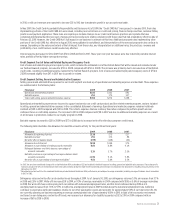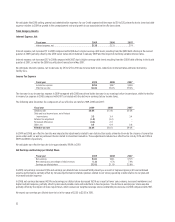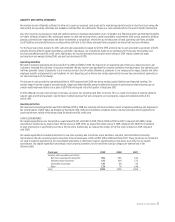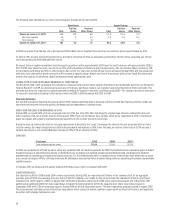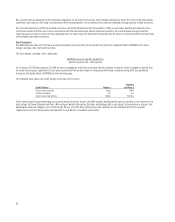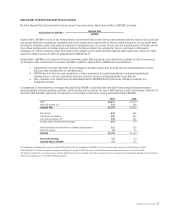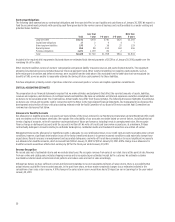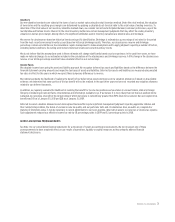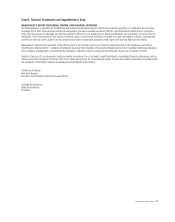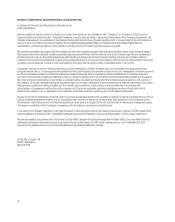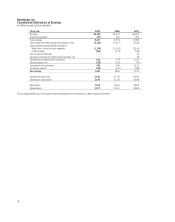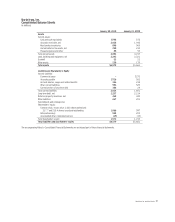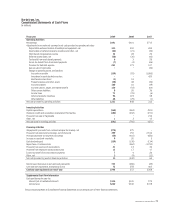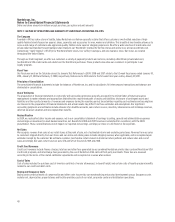Nordstrom 2009 Annual Report Download - page 38
Download and view the complete annual report
Please find page 38 of the 2009 Nordstrom annual report below. You can navigate through the pages in the report by either clicking on the pages listed below, or by using the keyword search tool below to find specific information within the annual report.
30
Contractual Obligations
The following table summarizes our contractual obligations and the expected effect on our liquidity and cash flows as of January 30, 2010. We expect to
fund these commitments primarily with operating cash flows generated in the normal course of business and credit available to us under existing and
potential future facilities.
Total
Less than
1 year 1–3 years 3–5 years
More than
5 years
Long-term debt $4,141 $478 $746 $625 $2,292
Capital lease obligations 17 2 4 4 7
Other long-term liabilities 195 3 38 25 129
Operating leases 854 98 190 160 406
Purchase obligations 1,221 1,139 80 2 -
Total $6,428 $1,720 $1,058 $816 $2,834
Included in the required debt repayments disclosed above are estimated total interest payments of $1,539 as of January 30, 2010, payable over the
remaining life of the debts.
Other long-term liabilities consist of workers’ compensation and general liability insurance reserves and postretirement benefits. The repayment
amounts presented above were estimated based on historical payment trends. Other long-term liabilities not requiring cash payments, such as
deferred property incentives and deferred revenue, were excluded from the table above. Also excluded from the table above are unrecognized tax
benefits of $48, as we are unable to reasonably estimate the timing of future cash payments for these liabilities.
Purchase obligations primarily consist of purchase orders for unreceived goods or services and capital expenditure commitments.
CRITICAL ACCOUNTING ESTIMATES
The preparation of our financial statements requires that we make estimates and judgments that affect the reported amounts of assets, liabilities,
revenues and expenses, and disclosure of contingent assets and liabilities. We base our estimates on historical experience and other assumptions that
we believe to be reasonable under the circumstances. Actual results may differ from these estimates. The following discussion highlights the estimates
we believe are critical and should be read in conjunction with the Notes to the Consolidated Financial Statements. Our management has discussed the
development and selection of these critical accounting estimates with the Audit Committee of our Board of Directors and the Audit Committee has
reviewed our disclosures that follow.
Allowance for Doubtful Accounts
Our allowance for doubtful accounts represents our best estimate of the losses inherent in our Nordstrom private label card and Nordstrom VISA credit
card receivables as of the balance sheet date. We evaluate the collectability of our accounts receivable based on several factors, including historical
trends of aging of accounts, write-off experience and expectations of future performance, including trends in unemployment rates. We recognize
finance charges on delinquent accounts until the account is written off. We write off credit card loans when accounts are, at a minimum, 151 days
contractually delinquent. Accounts relating to cardholder bankruptcies, cardholder deaths and fraudulent transactions are written off earlier.
Management believes the allowance for doubtful accounts is adequate to cover anticipated losses in our credit card accounts receivable under current
conditions; however, significant deterioration in any of the factors mentioned above or in general economic conditions could materially change these
expectations. Recent increases in unemployment and associated delinquency and write-off trends have prompted us to record significant increases to
our allowance for doubtful accounts, which increased from $138 at January 31, 2009 to $190 at January 30, 2010. A 10% change in our allowance for
doubtful accounts would have affected net earnings by $12 for the fiscal year ended January 30, 2010.
Revenue Recognition
We record sales net of estimated returns and we exclude sales taxes. We recognize revenue from sales at our retail stores at the point of sale. Revenue
from our online and catalog sales includes shipping revenue and is recognized upon estimated receipt by the customer. We estimate customer
merchandise returns based on historical return patterns and reduce sales and cost of sales accordingly.
Although we believe we have sufficient current and historical knowledge to record reasonable estimates of sales returns, there is a possibility that
actual returns could differ from recorded amounts. In the past three years, we have made no material changes to our estimates included in the
calculations of our sales return reserve. A 10% change in the sales return reserve would have had a $5 impact on our net earnings for the year ended
January 30, 2010.



